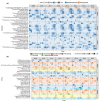Seasonal dynamics of marine protist communities in tidally mixed coastal waters
- PMID: 35593305
- PMCID: PMC9543310
- DOI: 10.1111/mec.16539
Seasonal dynamics of marine protist communities in tidally mixed coastal waters
Abstract
Major seasonal community reorganizations and associated biomass variations are landmarks of plankton ecology. However, the processes of plankton community turnover rates have not been fully elucidated so far. Here, we analyse patterns of planktonic protist community succession in temperate latitudes, based on quantitative taxonomic data from both microscopy counts (cells >10 μm) and ribosomal DNA metabarcoding (size fraction >3 μm, 18S rRNA gene) from plankton samples collected bimonthly over 8 years (2009-2016) at the SOMLIT-Astan station (Roscoff, Western English Channel). Based on morphology, diatoms were clearly the dominating group all year round and over the study period. Metabarcoding uncovered a wider diversity spectrum and revealed the prevalence of Dinophyceae and diatoms but also of Cryptophyta, Chlorophyta, Cercozoa, Syndiniales and Ciliophora in terms of read counts and or richness. The use of morphological and molecular analyses in combination allowed improving the taxonomic resolution and to identify the sequence of the dominant species and OTUs (18S V4 rDNA-derived taxa) that drive annual plankton successions. We detected that some of these dominant OTUs were benthic as a result of the intense tidal mixing typical of the French coasts in the English Channel. Our analysis of the temporal structure of community changes point to a strong seasonality and resilience. The temporal structure of environmental variables (especially Photosynthetic Active Radiation, temperature and macronutrients) and temporal structures generated by species life cycles and or species interactions, are key drivers of the observed cyclic annual plankton turnover.
Keywords: DNA metabarcoding; Western English Channel; annual succession; marine protists; temporal variability; time-series data.
© 2022 The Authors. Molecular Ecology published by John Wiley & Sons Ltd.
Conflict of interest statement
All authors declare that they have no conflict of interest.
Figures








References
-
- Allen, W. E. (1936). Occurrence of marine plankton diatoms in a ten year series of daily catches in Southern California. American Journal of Botany, 23(1), 60–63.
-
- Altenburger, A. , Blossom, H. E. , Garcia‐Cuetos, L. , Jakobsen, H. H. , Carstensen, J. , Lundholm, N. , Hansen, P. J. , Moestrup, Ø. , & Haraguchi, L. (2020). Dimorphism in cryptophytes—The case of Teleaulax amphioxeia/Plagioselmis prolonga and its ecological implications. Science Advances, 6(37), 1–9. 10.1126/sciadv.abb1611 - DOI - PMC - PubMed
-
- Aminot, A. , & Kérouel, R. (2007). Dosage automatique des nutriments dans les eaux marines: méthodes en flux continu. In Méthodes d’analyses en milieu marin, (pp. 250). Editions Ifremer.
Publication types
MeSH terms
Substances
LinkOut - more resources
Full Text Sources

